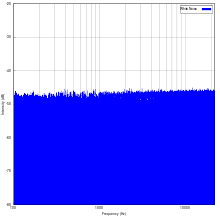Monday, September 22, 2014
Moog 903a Random Signal Generator brochure, 1976
Moog 903a Random Signal Generator two-sided brochure from 1976.
For the last couple of weeks I've been swooned by a series of Moog module brochures. This 903 Random Signal Generator brochure is the third in the series - after blogging on the Moog 921a/b oscillator bank and the Moog 921 voltage controlled oscillator module.
I gotta say, this series is shaping up to become a handsome set of brochures with those lovely front covers. Sweet.
There is one little difference with this latest brochure though. Those first two brochures each included four pages of juicy Moog-y goodness, but this latest 903a random generator module brochure consists of only one two-sided piece of paper. It's not a surprise though - that 903 panel is sparse-city, consisting of just dual white noise and pink noise outputs. No big dials, switches or flashing lights in the local vicinity.
That may give someone not familiar with noise generators the wrong idea. A noise module is a MUST for any modular. The back of the brochure goes into some good detail on how noise can be used effectively within a patch. Percussive sounds - check! Sound effects - yup! And of course there's the signal control applications as well like their involvement in creating randomly timed and tuned beep, boop, boop, beep, boops.
Growing up I loved noise. Not the really loud variety of clanging and banging (that came later) but that soothing noise that I find described so well by William Gibson in the opening line of Neuromancer:
"The sky above the port was the color of television, tuned to a dead channel."
I love that quote. and I also love the sound that often accompanied that screen "color" late at night when a television channel went off the air. SSHSHSHSHSHSHSHSH...
It wasn't until I got my Moog modular that I realized there was different "colours" of noise. And even then I wasn't too curious what the differences were for a long time. If you Google the topic you will soon learn there are a wack of different "colours "of noise - and as math is introduced into the equation (pun intended) if you are like me your head will begin to hurt a little bit.
According to Wikipedia, noise tends to be divided into two groups.
The first group are those colours of noise that have precise definitions:
White. Pink. Brown(ian). Blue. Violet. Grey.
In the case of this module, White noise has a "flat" frequency spectrum - "the signal has equal power in any band of a given bandwidth... when the bandwidth is measured in Hz". The example they use is that the sound power between the frequency range of 40Hz and 60Hz is equal to the sound power between 400Hz and 420Hz. Here's the chart for white noise from the Wikipedia page.
Pink noise, on the other hand, is linear in logarithmic space - "it has equal power in bands that are proportionally wide". Using the same example above, there is the same amount of sound power between 40Hz and 60Hz as there is between 4000-6000Hz. Now compare its spectrum chart below to the one for White noise above.
The visuals definitely help. :)
The second group are those with less precise definitions, synonyms for formally defined colours, or have multiple definitions - Red. Green. Black. Noisey White. Noisey Black.
I'm not even going to pretend I know *exactly*what they are talking about, but I get the idea.
I'll let you read the Wikipedia page to find out more info.
My head hurts. :D







No comments:
Post a Comment